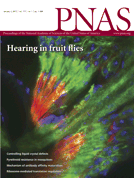PNAS:肿瘤活化蛋白促进癌症扩散
2013-05-17 佚名 医学论坛网
来自美国加州大学圣地亚哥医学院和圣地亚哥穆尔斯癌症中心的研究者,5月13日在线发表在《美国国家科学院院刊》上的最新一项研究结果表明:癌细胞发生生理改变的淋巴系统(一个传输和储存全身免疫细胞的血管网络)促进了疾病的扩散,这个过程又叫做转移。 大约90%的癌症死亡是由于转移—疾病从肿瘤的原始部位扩散到多个、远处组织,最终遍布病人全身。淋巴管往往是肿瘤传播的途径,循环肿瘤细胞停留在淋巴结—一种
来自美国加州大学圣地亚哥医学院和圣地亚哥穆尔斯癌症中心的研究者,5月13日在线发表在《美国国家科学院院刊》上的最新一项研究结果表明:癌细胞发生生理改变的淋巴系统(一个传输和储存全身免疫细胞的血管网络)促进了疾病的扩散,这个过程又叫做转移。
大约90%的癌症死亡是由于转移—疾病从肿瘤的原始部位扩散到多个、远处组织,最终遍布病人全身。淋巴管往往是肿瘤传播的途径,循环肿瘤细胞停留在淋巴结—一种遍布全身的器官,像是免疫系统的驻军、病原体和异物颗粒的陷阱。Judith A. Varner博士,是加州大学圣地亚哥穆尔斯癌症中心的医学教授,由她领导的研究人员们发现一种由肿瘤表达的蛋白生长因子,称为VEGF-C,它激活了一个叫做α4β1的受体,该受体位于淋巴结组织的淋巴管,这使得对转移性肿瘤细胞更具有吸引力和粘附力。
“这项工作最显著的特点之一是突出强调了一种方式,即肿瘤可以远距离影响身体其他部位,进而影响肿瘤的转移和生长。”Varner说。
Varner说既然淋巴组织中活化蛋白水平的升高是附近可能有一个未被发现的肿瘤的间接指标,那么α4β1可被证明是衡量癌症风险的一个有价值的生物标志物。
她说淋巴网络的全身成像扫描可能相对迅速和有效的找出问题的所在。“我们的想法是将放射性标记或者其他标记的抗整合蛋白α4β1抗体注入到淋巴循环系统,它会只结合并突出肿瘤存在且已经激活的淋巴管”
Varner指出,α4β1水平与转移有关—α4β1水平愈高,则癌症扩散几率愈大。经过额外的临床研究,医生们可以优化治疗方案,使高风险的病人得到适当治疗,而低风险或不会癌转移的患者不至于过度治疗。
研究人员在研究中发现,通过降低生长因子水平或阻断α4β1受体活化能够抑制肿瘤的转移。Varner说,VEGF-R3抗体目前在第1阶段临床试验。已被认可的人源化抗α4β1抗体目前已被批准用于治疗多发性硬化和克罗恩病。Varner说,她在加州大学圣地亚哥分校穆尔斯癌症中心的实验室正在探究抗体用于治疗癌症的可能性。

Tumor-activated protein promotes cancer spread
Researchers at the University of California, San Diego School of Medicine and UC San Diego Moores Cancer Center report that cancers physically alter cells in the lymphatic system – a network of vessels that transports and stores immune cells throughout the body – to promote the spread of disease, a process called metastasis.
The findings are published in this week’s online Early Edition of the Proceedings of the National Academy of Sciences.
Roughly 90 percent of all cancer deaths are due to metastasis – the disease spreading from the original tumor site to multiple, distant tissues and finally overwhelming the patient’s body. Lymph vessels are often the path of transmission, with circulating tumor cells lodging in the lymph nodes – organs distributed throughout the body that act as immune system garrisons and traps for pathogens and foreign particles.
The researchers, led by principal investigator Judith A. Varner, PhD, professor of medicine at UC San Diego Moores Cancer Center, found that a protein growth factor expressed by tumors called VEGF-C activates a receptor called integrin α4β1 on lymphatic vessels in lymph node tissues, making them more attractive and sticky to metastatic tumor cells.
“One of the most significant features of this work is that it highlights the way that tumors can have long-range effects on other parts of the body, which can then impact tumor metastasis or growth,” said Varner.
Varner said α4β1 could prove to be a valuable biomarker for measuring cancer risk, since increased levels of the activated protein in lymph tissues is an indirect indicator that an undetected tumor may be nearby.
She said whole-body imaging scans of the lymphatic network might identify problem areas relatively quickly and effectively. “The idea is that a radiolabeled or otherwise labeled anti-integrin α4β1 antibody could be injected into the lymphatic circulation, and it would only bind to and highlight the lymphatic vessels that have been activated by the presence of a tumor.”
Varner noted that α4β1 levels correlate with metastasis – the higher the level, the greater the chance of the cancer spreading. With additional research and clinical studies, doctors could refine treatment protocols so that patients at higher risk are treated appropriately, but patients at lower or no risk of metastasis are not over-treated.
The researchers noted in their studies that it is possible to suppress tumor metastasis by reducing growth factor levels or by blocking activation of the α4β1 receptor. Varner said an antibody to VEGF-R3 is currently in Phase 1 clinical trials. An approved humanized anti-α4β1 antibody is currently approved for the treatment of multiple sclerosis and Crohn’s disease. Varner said her lab at UC San Diego Moores Cancer Center is investigating the possibility of developing one for treating cancer.
Co-authors include Barbara Garmy-Susini, Christie J. Avraamides, Michael C. Schmid and Philippe Foubert, UC San Diego Moores Cancer Center; Jay S. Desgrosellier, UC San Diego Moores Cancer Center and UCSD Department of Pathology; Lesley G. Ellies, Scott R. Vanderberg, Brian Datnow, Huan-You Wang and David A. Cheresh, UCSD Department of Pathology; Andrew M. Lowy and Sarah L. Blair, UC San Diego Moores Cancer Center and UCSD Department of Surgery.
Funding for this research came, in part, from National Institutes of Health grants CA83133 and CA126820; Department of Defense grant W81XWH-06-1-052 and NIH-National Cancer Institute grant U54 CA119335.
本网站所有内容来源注明为“梅斯医学”或“MedSci原创”的文字、图片和音视频资料,版权均属于梅斯医学所有。非经授权,任何媒体、网站或个人不得转载,授权转载时须注明来源为“梅斯医学”。其它来源的文章系转载文章,或“梅斯号”自媒体发布的文章,仅系出于传递更多信息之目的,本站仅负责审核内容合规,其内容不代表本站立场,本站不负责内容的准确性和版权。如果存在侵权、或不希望被转载的媒体或个人可与我们联系,我们将立即进行删除处理。
在此留言










#PNAS#
53
#癌症扩散#
70